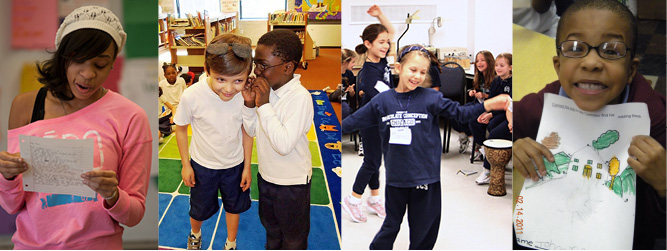If you’re wondering what ever happened to the Chicago Public Schools (CPS) Arts Education plan two years after its lauded unveiling – you’re probably not the only one. The good news is, movement is happening and arts education is now broadly recognized as a priority for Chicago schools, students, and citizens. The bad news is more of a question: Is the going too slow?
What is the plan?
A quick recap of what this is all about: The Chicago Public Schools Arts Education Plan was unveiled in 2012. It grew out of the 2012 Chicago Cultural Plan, a citywide initiative to strengthen Chicago’s standing as a creative destination and innovator. The Cultural Plan creation process, which included town hall meetings and community discussions, identified arts education for Chicago students as one of the community’s foremost concerns. Hence the birth of the CPS Arts Education Plan, which aims for all CPS elementary schools to provide 120 minutes of arts instruction per week, for each district school to have at least one certified arts teacher and an Arts Liaison, for each district school to have at least one community arts partnership, for dance and drama to be integrated as high school graduation requirements, and much more. Basically, it acknowledges the arts as core subject areas, equal in importance to academic subjects such as math and science. You can read details here.
What progress are we making?
Probably the most comprehensive and valuable summary of progress is the “State of the Arts in Chicago Public Schools” report released by Ingenuity, Inc. this summer, which examined how Chicago schools are living up to the Arts Education Plan. This link features the full report as well as summarized Key Findings. A few striking examples:
— Less than 25% of elementary schools provide the recommended 120 minutes of weekly arts instruction
— CPS employs almost as many arts instructors in total as it would need to meet the Arts Education Plan’s requirements, but their distribution across the district is significantly uneven (pointing to disparities in arts education access between schools and neighborhoods)
— Arts education funding exceeds $120 million annually (this includes CPS Department of Arts Education funding, donations to schools, donations to arts partners, etc), but this is not sufficient to meet the Plan’s goals
— While 82% of district schools have both an arts instructor and an arts partner, the depth of partnerships varies (many are one-time performances that lack much follow-up)
There are plenty of positives scattered throughout these findings, but limiting factors also abound.
What happens now?
In a word: Fundraising.
It’s no secret that CPS has seen dire financial times (as have public school districts nationwide); the district closed about 50 schools in 2013 in an effort to curb its deficit and cut significant funding for traditional neighborhood schools in its 2014-15 budget.
Accordingly, paying for the Arts Education Plan is no joke. On October 21, Mayor Rahm Emanuel and Board of Education President David Vitale announced that donors have pledged $10 million to “Be Creative: The Campaign for Creative Schools” to help move the Arts Education Plan forward; the campaign is seeking additional donations to meet its $38 million goal. This $38 million in private funding is intended to support arts education programs until the 2018-19 school year, at which point public funding would take over. The four-year buffer zone will hopefully offer a smooth funding transition.
— — —
There’s a long way to go, but here at Urban Gateways, we’ve already seen progress in the form of school partnerships. For the past two school years we have worked with a number of CPS schools to submit proposals for Creative Schools funding to support our programs. During the 2013-14 school year, we worked with 5 Creative Schools Fund grant recipients to provide $55,000 in arts education programs (primarily artist residencies). This year we are working with 4 of those same schools, in addition to submitting grants with 15 additional schools. We are optimistic that the 2014-15 school year will see us at least double the number of Creative Schools Fund grant recipients we work with. That’s a lot of students who may not otherwise have experienced arts education in their day-to-day lives.
In the end, the only solution to budgeting concerns is NOT to allow the Arts Education Plan to fall out of the spotlight as it ages. The Plan requires funding; the money is out there, but the chances of it making its way into the Campaign for Creative Schools coffer diminishes the more the subject flounders. So as for you, the arts education advocate: Share the idea, share its value – above all, keep talking.

